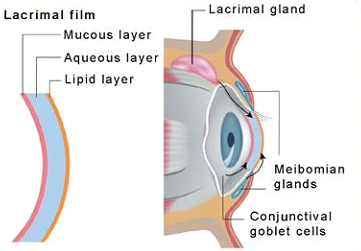What are the symptoms of dry eye?
The symptoms can vary:
- Foreign body sensation in the eyes
- Itching and burning in the eyes
- Tearing due to discomfort
- Red eyes
- Red eyelids
- Crusts at the base of
the lashes
- Abundant eye secretions
How does dry eye develop?
Several risk factors can contribute to the development of dry eye disease:
- Aging: The tear gland produces less tears with age, especially with
the decrease in estrogen levels following menopause in women.
- Blepharitis: this is an inflammation of the eyelid edge where the Meibomian glands are congested. This dysfunction reduces the quality of the tear film and
contributes to dry eyes.
- Eye treatments: Dry eyes may worsen after eye surgeries or with the use of certain eye drops.
- Systemic treatments: Some drugs can decrease production of tears (for example, decongestants, antihistamines,
diuretics, antidepressants).
- Contact Lenses: Prolonged use of contact lenses can also lead to dry eyes.
- Environment: Cold air (less humid), dry wind, heaters, fans and air conditioning can increase evaporation of tears.
What are the available treatments of dry eyes?
Dry
eyes are generally a chronic condition and require ongoing treatment:
- First-line treatment involves use of artificial tears regularly, as prescribed by your doctor.
- In case of insufficient production of tears, the tear
drainage canal of the eyelid may be temporarily or permanently closed by inserting a tear plug. This treatment retains more tears to lubricate the eye surface.
- In case of dysfunction of the meibomian glands, treatments
consisting of hot compresses and cleaning of the edges of the eyelid may be beneficial. Topical and / or systemic antibiotic may be helpful in refractory cases.
